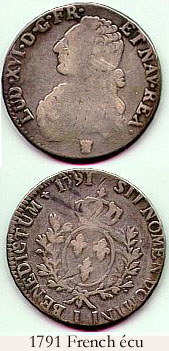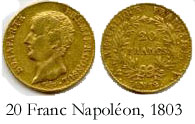Difference between revisions of "APAC100"
From Marist Studies
(→Excursus B : money matters) |
(→Excursus B : money matters) |
||
| Line 6: | Line 6: | ||
:The most often mentioned currency in the correspondence from Oceania is the French franc. In Australia and New Zealand the pound sterling was the more common currency although, perhaps because of the whalers, the Mexican quadruple too was in use in the Bay of Islands. The Frenchmen often kept thinking in terms of their familiar francs. | :The most often mentioned currency in the correspondence from Oceania is the French franc. In Australia and New Zealand the pound sterling was the more common currency although, perhaps because of the whalers, the Mexican quadruple too was in use in the Bay of Islands. The Frenchmen often kept thinking in terms of their familiar francs. | ||
:The pound swung for a long time around 25 francs, which puts the franc at about tenpence.<ref> Cf. Dillon writing to Colin, quoted in Wiltgen, op. cit. p. 217. in 1841 Fr. Garin writes to Colin of a gift of 30 pounds and explains: 600 francs; probably an unthinking remark, [[Girard0111|LRO, doc. 111]] [11].</ref> In 1851 Rocher wrote to Colin from Sydney that due to the gold rush he had to pay £ 26 for a ton of flour, and 30 centimes for a loaf of bread, threepence would have meant nothing to Colin.<ref> [[Girard1062|LRO, doc. 1062]] [12].</ref> | :The pound swung for a long time around 25 francs, which puts the franc at about tenpence.<ref> Cf. Dillon writing to Colin, quoted in Wiltgen, op. cit. p. 217. in 1841 Fr. Garin writes to Colin of a gift of 30 pounds and explains: 600 francs; probably an unthinking remark, [[Girard0111|LRO, doc. 111]] [11].</ref> In 1851 Rocher wrote to Colin from Sydney that due to the gold rush he had to pay £ 26 for a ton of flour, and 30 centimes for a loaf of bread, threepence would have meant nothing to Colin.<ref> [[Girard1062|LRO, doc. 1062]] [12].</ref> | ||
| − | :Sometimes there is mention of the ''écu'' (''scudo'' in Italian), which was a coin equivalent to three francs.<ref> [[APAC67|Above, p. 69]]. LC I, doc. 230.</ref> A ''Napoléon'' was a coin of 20 francs. Around South America the ''piastre'', equivalent to 5.5 francs, was often used. | + | :Sometimes there is mention of the ''sou'' which is five centimes, the ''écu'' (''scudo'' in Italian), which was a coin equivalent to three francs.<ref> [[APAC67|Above, p. 69]]. LC I, doc. 230.</ref> A ''Napoléon'' was a coin of 20 francs. Around South America the ''piastre'', equivalent to 5.5 francs, was often used. |
| − | :Gold was considered the basic standard for all currencies, and often money was sent in the form of gold coins. | + | :Gold was considered the basic standard for all currencies, and often money was sent in the form of gold coins. The gold coins in circulation in South America were Spanish, Mexican and Colombian so-called ''quadruples'' or ''doublons'' of one ounce of gold. In November 1836 they were traded in Paris for 84 or 85 francs, but the exchange rate varied according to the amount in circulation.<ref> Cf. [[Girard007|LRO, doc. 7]] [14] & [[Girard0059|LRIO, doc. 59]] [4].</ref> |
| + | :The 8.700 francs that Colin sent from France in May 1837 came to 100.72 ounces, which means just over 86 francs for one ounce of gold.<ref> Pompallier to Meynis, 17.03.1839, OPM, H30, 000867.</ref> | ||
Revision as of 21:58, 3 July 2008
Excursus B : money matters
- The most often mentioned currency in the correspondence from Oceania is the French franc. In Australia and New Zealand the pound sterling was the more common currency although, perhaps because of the whalers, the Mexican quadruple too was in use in the Bay of Islands. The Frenchmen often kept thinking in terms of their familiar francs.
- The pound swung for a long time around 25 francs, which puts the franc at about tenpence.[1] In 1851 Rocher wrote to Colin from Sydney that due to the gold rush he had to pay £ 26 for a ton of flour, and 30 centimes for a loaf of bread, threepence would have meant nothing to Colin.[2]
- Sometimes there is mention of the sou which is five centimes, the écu (scudo in Italian), which was a coin equivalent to three francs.[3] A Napoléon was a coin of 20 francs. Around South America the piastre, equivalent to 5.5 francs, was often used.
- Gold was considered the basic standard for all currencies, and often money was sent in the form of gold coins. The gold coins in circulation in South America were Spanish, Mexican and Colombian so-called quadruples or doublons of one ounce of gold. In November 1836 they were traded in Paris for 84 or 85 francs, but the exchange rate varied according to the amount in circulation.[4]
- The 8.700 francs that Colin sent from France in May 1837 came to 100.72 ounces, which means just over 86 francs for one ounce of gold.[5]
- Mass stipends in France were one franc and from a remark of Fr. Chanut to Marcellin Champagnat it would appear that for a priest of the time his daily Mass stipends meant a modest but adequate living allowance.[6]
- In 1839 Bataillon wrote that the Methodist missionaries (probably in Tonga) were paid a thousand francs (for man and wife) a year by their home organization. There was a special allocation for each child.[7] In 1848 the upkeep of a catholic missionary too was set at 1.000 francs a year. [8]
- Relating money values of the 1830’s and 1840’s to today’s money is a hazardous undertaking. Still, we probably are not far off if we consider one franc of that period to be something like € 12 or US$ 18 or £ 9 today (March 2008).
- When there is mention of a piastre we can think of € 66 or US$ 100 and £ 50.
- When they speak one pound sterling we can think of € 300, US$ 450 and £ 225 today.
Notes
- ↑ Cf. Dillon writing to Colin, quoted in Wiltgen, op. cit. p. 217. in 1841 Fr. Garin writes to Colin of a gift of 30 pounds and explains: 600 francs; probably an unthinking remark, LRO, doc. 111 [11].
- ↑ LRO, doc. 1062 [12].
- ↑ Above, p. 69. LC I, doc. 230.
- ↑ Cf. LRO, doc. 7 [14] & LRIO, doc. 59 [4].
- ↑ Pompallier to Meynis, 17.03.1839, OPM, H30, 000867.
- ↑ Cf. CS, doc. 53 [5] & doc. 317 [1].
- ↑ LRO, doc. 38 [10].
- ↑ Bernard Bourtot, Colin, les missions et leur financement en 1848, in Document SM Nr. 71, April 2007. Centre de Documentation Mariste, 6, rue Jean Ferrandi, 75006 Paris, p. 23.
A Piety Able to Cope Author Title Page foreword abbreviations introduction chapter one chapter two excursus A chapter three chapter four chapter five excursus B chapter six excursus C epilogue bibliography
| Previous Section | A Piety Able to Cope | Next Section |

